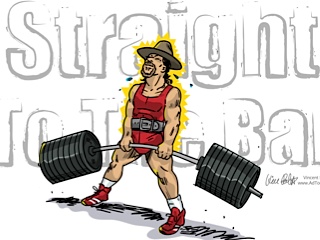I’ve never heard a Powerlifter speak about how they were going to hit barbell training for their workout that day. At the same time I’ve never heard an Olympic lifter talk about their success in barbell lifting. While both use barbells the emphasis is not on the barbell rather how and why they lift them in the context of optimizing their training.
Novel idea, but we should have that thought process with all training tools we utilize in our training programs. When I first began using sandbags I made the mistake most people make. I used sandbags primarily because they were awkward and difficult to lift. I really didn’t think why or how what I was doing was really impacting my overall training other than I might be hitting stabilizers or strengthening my core.
In the last seven years of using sandbags I have found they can be one of the most powerful training tools in increasing performance, mobility, strength, and conditioning. The trick is you have to understand why and how you use them to maximize their benefits. Creating a systemized approach changed the way I saw “sandbag lifting” and just as Powerlifting, Bodybuilding, and Olympic Lifting have definitive methods and techniques I believe sandbag training deserves the same : more accurately it’d be getting away from “sandbag lifting“. Let’s change what the implement is and focus more on what we are trying to achieve; thinking in terms of Dynamic Variable Resistance Training (DVRT) helps us get started.
Rule 1: How you hold the sandbag means EVERYTHING!
Watching most programs and videos of people lifting sandbags, I know they have never given thought to the impact holding the sandbag has on the exercise or performance of the movement. However, determining how you hold the sandbag dictates everything in regards to what you wish to accomplish by performing the movement.
The barbell has four standard positions (possibly 5 for some of the odd lifts), kettlebells are similar, but sandbag training in the DVRT system has NINE! This means we can manipulate how the body perceives a weight, stability, and challenge both at once if we want.
Looking at the first three positions in sandbag training (Bear Hug, Zercher, Shoulder) they are significantly different upon their use and effects. The Bear Hug position aligns the weight with the lifter’s center of gravity making it the easiest position to add load upon. The Bear Hug position can also be seen as the basis for teaching correct movement patterns as the weight of the sandbag will act as a counterbalance allowing for a more upright position and deeper squat position. This equals less unnecessary stress upon the low back and the deeper squat position allows for maximizing glute and hamstring activation while opening up the hips as well. All of a sudden what appears to be a simple exercise can be a foundational lift of any program.
The Bear Hug Squat :
Because sandbag training does not lend itself to incremental loading we first change the holding position of the sandbag and then change body position. Moving from Bear Hug to Zercher changes the center of gravity and creates more stress upon the trunk and upper back; providing what can be perceived as a larger load even if the actual weight of the sandbag has not been altered. Looking more deeply at the movement we see that the Zercher Squat in sandbag training not only is more difficult but becomes a powerful trunk anti-flexion exercise. You can see the similarity of the Zercher position and the common plank exercise, except now we are adding motion to the plank!
The third sandbag training holding position is Shoulder. Unfortunately, this is the very place that most people begin! If the Zercher position is related to the front plank Shouldering is closely related to side plank. The stress of large frontal plane loads make the Shoulder position the most challenging to move while maintaining correct posture alignment. The Shoulder position in our DVRT system is known as one of the most difficult asymmetrical loading postures. Experts agree that asymmetrical loading is one of the most important “unused” aspects in training.
“The longer I’m in this industry and the more people I train, the more emphasis I seem to place on asymmetrical loading. For decades, we worked to get people off machines and into doing more free weights because of the stability benefits they afford.”
– Eric Cressey
Like many misunderstood aspects of sandbag training, the value of sandbag shouldering in providing asymmetrical loading is very undervalued; especially with the load being applied directly on the body, causing more of the smaller stablizers of the spine and trunk to be active then more common variations of holding a weight to the side of the body. If we understand the role of these patterns then we can also create proper progressions and regressions so we can see continual progress in the training.
The Shouldering position is also ideal because we can use it as an assessment for core and pelvic stability. As one performs a more stable lift (eg. Shoulder Squat) we can watch for movement of the hip and body towards one side or the other during the exercise. This tells us a compensation pattern and inability to stabilize by the lifter is causing such negative movement. We know as coaches now about how to then regress the lifter so we can fix those instabilities and make them a better athlete, lifter, or flat out just healthier.
Asymmetrical sandbag loading :
Rule #2: Role of Body Position
Understanding the role of body position while performing sandbag training is vital in increasing performance. Because sandbags never will (and shouldn’t) come close to the loads of a barbell we can make lighter weights feel heavier by changing body position. This accomplishes several goals.
Because sandbag training does not lend itself to incremental loading, we can alter body position to make a lighter weight feel heavier as a form of progressive training of heavier sandbag loads. Sandbag Training should be more about maintaining posture under unstable loads and unstable positions. This ensures more strengthening of the more commonly missed stabilizers and patterns. The result? Such training can enhance strength and stability in the more common gym lifts, but the reverse isn’t true!
We can more accurately identify weak links because in these more unstable environments we see true movement skills.
Such training involves progressively moving to more single leg stances. Not just doing single leg exercise in their normal setting, but trying to produce power and resist load and movement in these positions.
Rule #3: Different Planes of Motion
Some scoff at the idea that working in different planes of motion has an impact on performance. “Just get strong” some would have you believe, but that thought process has many holes. As Strength Coach Bret Conteras writes:
“Rotary stability is the body’s ability to resist undesired movement in the axial twist axis. Technically, all of the body’s major joints require stability to resist torsion, but the major players are definitely the hips and spine.
Initially, most beginners possess the leg strength necessary to perform a Bulgarian split squat, however they often lack hip stability in the frontal (side to side) and transverse (rotary) planes.
If the hip stabilizers are weak or don’t fire in synchronicity, the prime movers (quads, glute max, hamstrings) won’t receive an adequate training stimulus until the hip stabilizers (adductors, glute med and min, TFL, upper glute max, hip rotators, etc.) are sufficiently strong and coordinated.”
The problem is that most of the common fitness tools don’t lend themselves to working at progressive levels of complexity for such goals. This is where sandbag training can really take strength training to another level.
Our goal in DVRT is to have the body move in planes of motion under load and maintain good alignment. This sounds easy but as we move in one plane and load starts to move in other planes of motion things get far more interesting.
Examples of multi-planar strength :
There are many other “rules” we can delve into, but really these aren’t rules as much as they are guidelines so that you can actually find the benefits of sandbag training expand far beyond lifting a bag of sand. Variation and fun are great, just because we use innovative lifting guidelines to dictate our training it doesn’t take away from variation and fun but expands it because our results become better! Try implementing these concepts and see how your training can become accelerated.











0 Comments